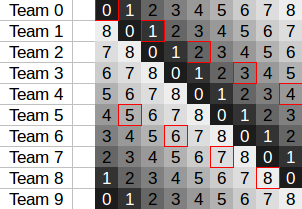I have just developed a match scheduling algorithm and had to use some pretty funny modular arithmetic. While it works fine i would like to know if my calculations could be simplified any further.
Though it looks a little complicated it's in fact very simple and seems to work very efficiently.
A little bit explanation on my approach;
So for starters, i have 10 teams to match up. Each team will play 9 matches in a fixture such that all teams play with a separate competition at every round.
Accordingly i have an array of team objects as follows;
var teams = [{id: team_0, matches : []}, ... ,{id: team_9, matches: []}]
I would like to show the general layout of the fixture in the table below;
Where mc is the match count, which is 9 in this example. The items with green background are the ones we calculate by iterating over and the red foreground ones are calculated automatically from the iterated ones. Dark green background is the starting index for insertion of the competitors into the matches array.
So for T0 we start with an empty 9 item matches array to be filled with the competitors. However our first competitor will be the last one and then we will continue from the first one like T9 -> T1 -> T2... -> T8. As I have experienced this odd initial ordering results simpler code but i am open to suggestions.
While we are filling the matches array of T0 with a value such as T9 (T0 line first item with dark green background) we also fill same index of the matches array of T9 with T0. (T9 line first item in red)
When we finish T0's matches and come to T1, we already have one item of T1's matches filled while we were calculating the T0 matches. (row T1 column 1, T0 in red) So we start after that one again with T9 and continue with T2 (not T1, since T1 can not play with itself) up until we reach T8. This is where the modulus arithmetic starts showing itself by assigning T8 at index 0.
So this is why I had to come up with some funny modular arithmetic;
(2*i+j) % mc: Is the calculated index to start inserting results from T9 on.(j+mc-i-1) % (mc-i)+i+1: Is the calculated index to pick the competitor from the teams array.
Again i can not make exactly sure if they can be simplified any further but they seem perfectly functional as they are. This is where i need your help.
So the code is;
function fixture(ts){
var mc = ts.length-1, // match count is one less than the total number of teams.
sp = 0, // calculated start position to insert matches in the matches array.
tm = 0; // competing team's calculated index at the input (ts) array.
return ts.map((t,i,a) => (a.slice(i+1)
.forEach(function(_,j,b){
sp = (2*i+j) % mc;
tm = (j+mc-i-1) % (mc-i)+i+1;
t.matches[sp] = a[tm].id;
a[tm].matches[sp] = t.id;
})
,t));
}
var tc = 10,
teams = Array(tc).fill().map((_,i) => ({id: "Team_"+i, matches: Array(tc-1)}));
result = fixture(teams);
console.log(teams);.as-console-wrapper { max-height: 100% !important; top: 0; }Advises to further simplify this code are most welcome.




